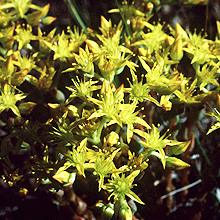Herbs, annual, biennial, or weakly perennial, tufted or not, glabrous. Stems decumbent, branched, bearing terminal rosettes. Leaves alternate, spreading to erect, sessile; blade green, not glaucous, linear to elliptic-oblong (subulate when dry), subterete, 4.3-13.8 × 1.4-2.7 mm, base (persistent), spurred (spur simple, small), scarious, apex acute, (surfaces sometimes papillose marginally). Flowering shoots erect, branched, 10-43 cm; leaf blades linear, base with scarious spurs; offsets rosettes, produced from axils of leaves and bracts. Inflorescences solitary flowers or cymes, 9-15 (-25)-flowered, mostly 3-branched; branches slightly recurved, not forked; bracts linear-lanceolate, smaller than leaves, base spurred. Pedicels absent or to 0.5 mm. Flowers 5-merous; sepals erect, distinct, pale green or yellow-green, lanceolate or ovate, equal, 2-3.7 × 0.9-1.7 mm, apex acute or long-acuminate; petals stellately spreading, distinct, deep yellow with green to brown dorsal keel to almost white, lanceolate or elliptic, slightly carinate, 5.4-8 mm, apex obtuse, acute, or long-acuminate, sometimes with aristate appendage; filaments yellow; anthers yellow; nectar scales greenish yellow or yellowish white, reniform-subquadrate or square. Carpels divergent in fruit, shortly connate, pale green, yellow-green, or brown. 2n = 50-54, 58, 62-70, 63-64.
More
A herb that keeps growing from year to year. It grows in clumps. It grows 8-20 cm high. The stems are short, fleshy and succulent. The flowers are yellow and 1.3 cm across. They occur in a compact cluster. The fruit are small pods that occur in a group.
Cliffs, talus slopes, rocky meadows, open woods, scab-land; from 300-3,100 metres (var stenopetalum). Ledges, shelves, steep slopes, and cliffs in gravel or thin soil over a variety of rocks; from 400-2,000 metres (var monanthum).
More
It grows in cracks in rocky places. They can survive frozen soils and drought.

